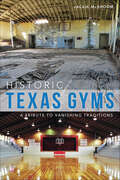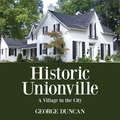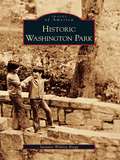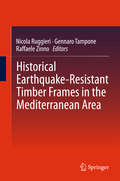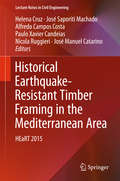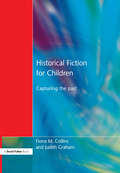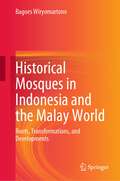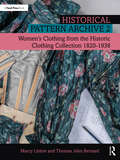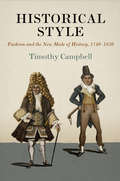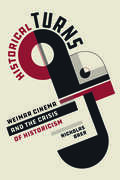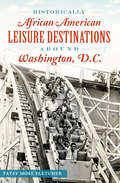- Table View
- List View
Historic Tales of Windham (American Chronicles)
by Al Letizio Jr. Derek Saffie Rick HolmesThe natural beauty and fertile lands of Windham drew first the Pawtucket Indians and then Scotch-Irish settlers. The town's rich history is full of intriguing stories, including Wallace Fessenden's unscrupulous baseball umpiring, the return of a native son after his burial at sea in Indonesia and the poetic life of the Rustic Bard, Robert Dinsmoor. Tourism boomed as early as the 1850s, when visitors flocked to the waterside temptations of Canobie Lake and later Cobbett's Pond, where eccentric millionaire Edward Searles built his famous castle. Local historian Derek Saffie weaves together a collection of historic stories from the settlement's roots as Nutfield to the town of Windham.
Historic Texas Gyms: A Tribute to Vanishing Traditions (Landmarks)
by Jackie McBroomFor generations of small-town Texans, the school gymnasium was the hub of the community. If it was a Tuesday night in Texline, most folks could be found in the old tin barn of a gym, rooting for their Tornadoes against the arch-rival Adrian Matadors. Transcending the role of a sports arena, the gym also provided a place to gather in celebration or shelter in crisis. Sadly, with the dramatic reduction of school districts around the state, many of the polished floorboards that once hosted graduations and beauty pageants now splinter beneath the weight of storage, farm equipment and guano-covered junk. From the pickup basketball game Elvis played in Hawkins to the tragic account of four Ennis war heroes, Jackie McBroom recounts stories from these beloved halls.
Historic Theaters of Youngstown and the Mahoning Valley (Landmarks)
by Sean T. PoseyHistoric Theaters of Youngstown and the Mahoning Valley traces the evolution of modern cinema through the rich local history of the Mahoning Valley.From the days of the gaslit opera houses through the era of the drive-in, the Mahoning Valley's theatrical culture has thrived. The finest theaters in northeastern Ohio rose with the manufacturing might of the Steel Valley. The Warner brothers, who started their careers in Youngstown, opened their first theater in New Castle, Pennsylvania, and celebrities from Katharine Hepburn to Red Skelton graced local stages. The finest vaudevillians and the lovely ladies of burlesque were always a ticket away. Take a trip back to the Park Burlesque and the opulent Palace Theater and revisit the theater culture of Warren and Trumbull County. Author Sean T. Posey traces the evolution of modern cinema through the rich local history of the Mahoning Valley.
Historic Unionville: A Village in the City
by George DuncanA guided tour of historic Unionville, a little Ontario village bursting with historic buildings full of stories. Unionville is a village in the city — an unexpected oasis where time seems to move a little more slowly than in the hectic world of condos, commercial strips, and traffic gridlock. Since the late 1960s, when Unionville and its vintage Main Street were “discovered,” the village has been a magnet for visitors. Historic Unionville is the first detailed exploration of the facts and folklore behind Unionville’s winding ways and eclectic architectural sights, which span two centuries from the Georgian to the Postmodern. Touring the heritage sites that still stand proudly in the community as signposts to the past, George Duncan brings to life stories of the people, places, and events behind this unique and inviting Ontario village.
Historic Washington Park
by Suzanne Wildrey BraggWashington Park and its neighborhood are steeped in history. When the Moravians settled in Salem in 1766, the hills to the south were used for hunting and, eventually, farming. In the late 1880s, when it became fashionable to build homes on elevated land, the bluffs became one of the most desirable residential areas to emerge in the early decades of Winston-Salem's boom. The plan for its development, built around the electric streetcar line, was designed by Jacob Lott Ludlow, who was also responsible for the West End plat. The Washington Park neighborhood became home to many of the area's wealthiest families, as well as the burgeoning middle class. Their lives, traditions, and habits helped shape the future of Winston-Salem. Today Washington Park is known for its grand mansions, nestled among the many bungalows, with superb views of downtown high-rises. The park, with its rolling hills and beautiful trails, provides a playground for the young and old alike. With the North Carolina School of the Arts located next door, the neighborhood is eclectic, elegant, and unique. This diversity has attracted a varied group of residents, all of whom share pride in their home, gardens, and noted creativity.
Historic West Salem (Images of America)
by Michael L. BrickerWest Salem is located in the southeast corner of Winston-Salem. It has the historical distinction of containing the land that made up the farms and industry of Colonial Salem. While East Salem, the congregational town and village, controlled business and religious interests, West Salem provided the heart, soul, and backbone of the area with the work of its blue-collar residents. The residents produced the food, mills, and industrial interests that allowed the town to function so successfully in its early years. Throughout West Salem's history, it always triumphed over such challenges as wars and the Great Depression. Images of America: Historic West Salem showcases the stories and photographs of the regular folks whose hard work and sacrifice fueled the greatness of our American leaders.
Historic Whitefish Bay: A Celebration of Architecture and Character
by Thomas Fehring Jefferson J. AikinIncorporated in 1892, Whitefish Bay is a pleasant, verdant village that is home to more than fourteen thousand people. More than half of its five thousand houses and other structures have been deemed historic or architecturally important. Even casual passersby can attest to the architectural significance of these buildings, and while the personal history attached to them is less apparent, it is no less dramatic. Their walls retain the stories of their remarkable inhabitants, from the outhouse where the first village president disappeared in 1899 with $20,000 in public funds to the lakeside Beaux-Arts mansion built by a Schlitz Brewing Company heir with eight varieties of Italian marble. Jefferson J. Aikin and Thomas H. Fehring examine these landmark treasures and the legacy of the residents they help preserve.
Historic Wilson in Vintage Postcards (Postcard History Series)
by J. Robert Boykin IIIWilson, North Carolina was formed in 1849 when the villages of Toisnot and Hickory Grove merged together. Named for Mexican War hero Gen. Louis D. Wilson, the new town came to be known for agriculture and education. The Wilson of today holds fast to its roots, offering antique shops laden with treasures from all walks of life and nationally recognized historic districts brimming with remarkable structures, significant styles of architecture, and numerous locations to taste the famed Eastern North Carolina style of barbecue. Historic Wilson in Vintage Postcards is a priceless collection of images that depict, among other views, the Wilson Depot from the late 1800s, local businesses, street scenes, churches, cotton and tobacco, and residential areas. The volume also affords readers postcards of Nash Street when it was considered "one of the most beautiful streets in America," tobacco scenes when Wilson was "the world's largest tobacco market," and the infamous 1911 trial of the Lewis West gang.
Historic Wonders: Legendary Temples
by Portrait AdvertisingThis book is a series that traces the enchanting and lesser known stories behind the creation of the well known temples, monuments and landmarks in India.
Historical Burial Grounds of the New Hampshire Seacoast (Images of America)
by Glenn A. KnoblockHistoric Burial Grounds of the New Hampshire Seacoast, a photographic study of Colonial Era-burial grounds, uncovers the fascinating history of the area from the 1680s to 1810. These early cemeteries are a direct link to our past, and yet very little has been done to preserve their history through photographs. By understanding how, why, and by whom these gravestones were made, the symbolism they portray can be understood, and we will gain a clearer understanding of the ways in which our ancestors lived and died. The burial grounds and the gravestones within them have often been called "open air museums." They contain some of the oldest works of art found in the area; some gravestones are more than 300 years old. Through the author's collection of photographs, one can see the entire range of images present in the area's old burial grounds, including grinning skulls and crossbones, heavenly cherubs, and epitaphs that tell magnificent tales. This collection is a must for anyone interested in local history, genealogy, or colonial-era art.
Historical Earthquake-Resistant Timber Frames in the Mediterranean Area
by Nicola Ruggieri Gennaro Tampone Raffaele ZinnoThis book presents a selection of the best papers from the HEaRT 2013 conference, held in Cosenza, Italy, which provided a valuable forum for engineers and architects, researchers and educators to exchange views and findings concerning the technological history, construction features and seismic behavior of historical timber-framed walls in the Mediterranean countries. The topics covered are wide ranging and include historical aspects and examples of the use of timber-framed construction systems in response to earthquakes, such as the gaiola system in Portugal and the Bourbon system in southern Italy; interpretation of the response of timber-framed walls to seismic actions based on calculations and experimental tests; assessment of the effectiveness of repair and strengthening techniques, e. g. , using aramid fiber wires or sheets; and modelling analyses. In addition, on the basis of case studies, a methodology is presented that is applicable to diagnosis, strengthening and improvement of seismic performance and is compatible with modern theoretical principles and conservation criteria. It is hoped that, by contributing to the knowledge of this construction technique, the book will help to promote conservation of this important component of Europe's architectural heritage.
Historical Earthquake-Resistant Timber Framing in the Mediterranean Area
by Nicola Ruggieri Helena Cruz José Saporiti Machado Alfredo Campos Costa Paulo Xavier Candeias José Manuel CatarinoThis book presents a selection of the best papers from the HEaRT 2015 conference, held in Lisbon, Portugal, which provided a valuable forum for engineers and architects, researchers and educators to exchange views and findings concerning the technological history, construction features and seismic behavior of historical timber-framed walls in the Mediterranean countries. The topics covered are wide ranging and include historical aspects and examples of the use of timber-framed construction systems in response to earthquakes, such as the gaiola system in Portugal and the Bourbon system in southern Italy; interpretation of the response of timber-framed walls to seismic actions based on calculations and experimental tests; assessment of the effectiveness of repair and strengthening techniques, e. g. , using aramid fiber wires or sheets; and modelling analyses. In addition, on the basis of case studies, a methodology is presented that is applicable to diagnosis, strengthening and improvement of seismic performance and is compatible with modern theoretical principles and conservation criteria. It is hoped that, by contributing to the knowledge of this construction technique, the book will help to promote conservation of this important component of Europe's architectural heritage.
Historical Fiction for Children: Capturing the Past
by Judith Graham Fiona M. CollinsHistorical fiction has a great deal to offer as its readers and devotees have always known. The time is ripe however for the historical novel and historical picture book to be promoted more emphatically so that many more are made aware of the delight and learning to be found in the genre. The editors of this book invited authors, academic writers and teachers to reflect on the nature, scope, range and richness of historical fiction for children. What is collected here provides an overview of the field, a consideration of significant writers of historical fiction from the nineteenth century onwards, a sense of the various historical eras commonly explored (Stone Age to World War 2), a discussion of commonly raised issues, themes and topics such as child labor, slavery and migration, and a forum for writers to reveal their insights into the writing of historical fiction. Julian Atterton, Berlie Doherty, Michael Foreman and Philip Pullman have made contributions. It provides evidence of children and students engaging creatively with historical fiction.
Historical Heartthrobs
by Kelly Murphy Hallie FrydHistory is about much more than dusty books, dreary dates, and long-forgotten battles. History is also about sex appeal! Historical Heartthrobs compiles photos and life stories of 50 of the sexiest men and women from history and asks the essential question: Would you really want to date them? Consider George Sand, for instance. She was the hottest thing in pants in nineteenth-century France, but would you really want to put up with all that smoking? Or what about Nikola Tesla? His utter brilliance made Victorians swoon, but he seemed incapable of swooning back. Would you endure his indifference in return for that incredible smile? Each entry in Historical Heartthrobs includes a full-page photo, contemporary quotes, and an in-depth explanation of who these people were, why they mattered, and how they managed to be so seductive. Entries also include: Vital stats about the hottie's place of birth, lifespan, and major areas of influence. The inside scoop on peccadilloes, noteworthy liaisons, and long-standing relationships. An overall heat reading that factors in sex appeal, charisma, accomplishments, and of course, moral virtue. (Points are docked for brutality and rudeness!) Everyone included here made their mark on the world--but not everyone did so in an equally admirable fashion. John Wilkes Booth was definitely good-looking, but racist assassins don't generally make for the best life partners. Nellie Bly, on the other hand, did more in her average year than most people do in a lifetime--and she happened to look like a model, too. So review their records, check out their photos, and choose the hottie who makes you swoon.
Historical Heartthrobs: 50 Timeless Crushes — From Cleopatra to Camus
by Kelly Murphy Hallie FrydThis book compiles photos and life stories of fifty of the sexiest men and women from history and asks the essential question: Would you really want to date them? Some are artists, some are scientists, and many are political or military leaders, but all have had a lasting impact on human life—and a sizable impact on their admirers as well. Each entry describes the period in which the heartthrob lived and includes essential stats, hilarious sidebars, and, of course, a "crushability" ranking: a measurement of how crush-worthy these people really are, based on their relative levels of heroism (or villainy).
Historical Mosques in Indonesia and the Malay World: Roots, Transformations, and Developments
by Bagoes WiryomartonoThe book is an interdisciplinary study on the relationship between Muslims and their mosques in Indonesia and Malaysia. It presents selected historic mosques that demonstrate local interpretations and sociocultural assimilation, as well as a geographical syncretism, of Islam in local societies. The book unveils the contestations, synchronizations, assimilations, and integrations of local and foreign elements into the contextual architecture and sociologically institutionalized system that is the mosque: the Islamic place of worship. The author excavates the mosque’s historical origins and traces the iconic elements, features, and designs from their earliest historical settings and contexts. He then identifies, analyzes, and theorizes the outcomes of the interaction between Islam and local traditions through Malaysian and Indonesian case studies. The book proposes that Islam, at its philosophical level, can be culturally acceptable anywhere because it contains universal virtues of humanity for equality, fraternity, and social justice. The book unfolds how a dialectical contestation and acculturation of Dutch colonialism, Middle Eastern elements of culture, and local customs and traditions, might then come into dialogue, peacefully. Finally, the book considers the relationship between Malay and Indonesian architecture within their respective political cultures, shedding light on Islam and its practice within rich multicultural contexts. Relevant to students and researchers in Islamic studies, architecture, and Southeast Asian studies more broadly, the book uncovers the issues, constraints, and opportunities relating to the meaning of mosques for Muslims in Malaysia and Indonesia.
Historical Narratives of Global Modern Art (Routledge Research in Art History)
by Irina D. Costache Clare KunnyDiversifying the current art historical scholarship, this edited volume presents the untold story of modern art by exposing global voices and perspectives excluded from the privileged and uncontested narrative of “isms.” This volume tells a worldwide story of art with expanded historical narratives of modernism. The chapters reflect on a wide range of issues, topics, and themes that have been marginalized or outright excluded from the canon of modern art. The goal of this book is to be a starting point for understanding modern art as a broad and inclusive field of study. The topics examine diverse formal expressions, innovative conceptual approaches, and various media used by artists around the world and forcefully acknowledge the connections between art, historical circumstances, political environments, and social issues such as gender, race, and social justice. The book will be of interest to scholars working in art history, imperial and colonial history, modernism, and globalization.
Historical Narratives of Global Modern Art (Routledge Research in Art History)
by Irina D. Costache Clare KunnyDiversifying the current art historical scholarship, this edited volume presents the untold story of modern art by exposing global voices and perspectives excluded from the privileged and uncontested narrative of “isms.” This volume tells a worldwide story of art with expanded historical narratives of modernism. The chapters reflect on a wide range of issues, topics, and themes that have been marginalized or outright excluded from the canon of modern art. The goal of this book is to be a starting point for understanding modern art as a broad and inclusive field of study. The topics examine diverse formal expressions, innovative conceptual approaches, and various media used by artists around the world and forcefully acknowledge the connections between art, historical circumstances, political environments, and social issues such as gender, race, and social justice. The book will be of interest to scholars working in art history, imperial and colonial history, modernism, and globalization.
Historical Pattern Archive 2: Women’s Clothing from the Historic Clothing Collection 1820-1938
by Thomas John Bernard Marcy LintonHistorical Pattern Archive 2 features a collection of women’s period garment patterns taken from the Historic Clothing Collection at the University of Virginia.The book offers an accurate pattern of each garment on a 1/8" graph that can be used to scale the pattern up to its original size, photographs of each piece from multiple angles, instructions about how the original garment was constructed, and details on what materials were used. Capturing research and information about garments that would have otherwise stayed hidden or eventually disappeared, this volume is designed to be a tool to preserve history through documenting vintage clothing.Written for historians, reenactors, costumer makers, and costume designers, Historical Pattern Archive 2 will enable readers to study the history behind each piece, implement their original techniques and recreate unique garments that are both beautiful and historically accurate.
Historical Pattern Archive: Women’s Clothing 1837-1969
by Thomas John Bernard Marcy LintonHistorical Pattern Archive: Women’s Clothing 1837–1969 is the first book of its kind to capture such a wide range of women’s period patterns in one book, featuring 83 patterns spanning over a century of clothing. The book offers an accurate pattern of each garment on a 1/8" graph that can be used to scale the pattern up to its original size, drawings of each piece from multiple angles, and instructions about how the original garment was constructed and what materials were used. Capturing research and information about garments that would have otherwise stayed hidden or disappeared permanently due to age, wear, or poor storage conditions, this volume is designed to be a tool to preserve history through documenting vintage clothing. Written for historians, reenactors, costumer makers, and costume designers, Historical Pattern Archive will enable readers to study the history behind each piece, implement their original techniques, and recreate unique garments that are both beautiful and historically accurate.
Historical Style: Fashion and the New Mode of History, 1740-1830 (Material Texts)
by Timothy CampbellHistorical Style connects the birth of eighteenth-century British consumer society to the rise of historical self-consciousness. Prior to the eighteenth century, British style was slow to change and followed the cultural and economic imperatives of monarchical regimes. By the 1750s, however, a growing fashion press extolled, in writing and illustration, the new phenomenon of periodized fashion trends. As fashion fads came in and out of style, and as fashion texts circulated and obsolesced, Britons were forced to confront the material persistence of out-of-date fashions. Timothy Campbell argues that these fashion texts and objects shaped British perception of time and history by producing new curiosity about the very recent past, as well as a new self-consciousness about the means by which the past could be understood.In a panoptic sweep, Historical Style brings together art history, philosophy, and literary history to portray an era increasingly aware of itself. Burgeoning consumer society, Campbell contends, highlighted the distinction between the past and the present, created an expectation of continual change, and forged a sense of history as something that could be tracked through material objects. Campbell assembles a wide range of writings, images, and objects to render this eighteenth-century landscape: commercial dress displays and David Hume's ideas of novelty as historical form; popular illustrations of recent fashion trends and Sir Joshua Reynolds's aesthetic precepts; fashion periodicals and Sir Walter Scott's costume-saturated historical fiction. In foregrounding fashion to trace eighteenth-century historicism, Historical Style draws upon the interdisciplinary, multimedia archival impressions that fashionable dress has left behind, as well as the historical and conceptual resources within the field of fashion studies that literary and cultural historians of eighteenth-century and Romantic Britain have often neglected.
Historical Turns: Weimar Cinema and the Crisis of Historicism
by Nicholas BaerHistorical Turns reassesses Weimar cinema in light of the "crisis of historicism" widely diagnosed by German philosophers in the early twentieth century. Through bold new analyses of five legendary works of German silent cinema—The Cabinet of Dr. Caligari, Destiny, Rhythm 21, The Holy Mountain, and Metropolis—Nicholas Baer argues that films of the Weimar Republic lent vivid expression to the crisis of historical thinking. With their experiments in cinematic form and style, these modernist films revealed the capacity of the medium to engage with fundamental questions about the philosophy of history. Reconstructing the debates over historicism that unfolded during the initial decades of moving-image culture, Historical Turns proposes a more reflexive mode of historiography and expands the field of film and media philosophy. The book excavates a rich archive of ideas that illuminate our own moment of rapid media transformation and political, economic, and environmental crises around the globe.
Historically African American Leisure Destinations Around Washington, D.C. (American Heritage)
by Patsy Mose FletcherFrom the late nineteenth to the mid-twentieth century, African Americans in the Washington, D.C. area sought leisure destinations where they could relax without the burden of racial oppression. Local picnic parks such as Eureka and Madre's were accessible by streetcars. Black-owned steamboats ferried passengers seeking sun and sand to places like Collingwood Beach, and African American families settled into quiet beach-side communities along the Western Shore of Maryland. Author and public historian Patsy M. Fletcher reveals the history behind Washington's forgotten era of African American leisure.

